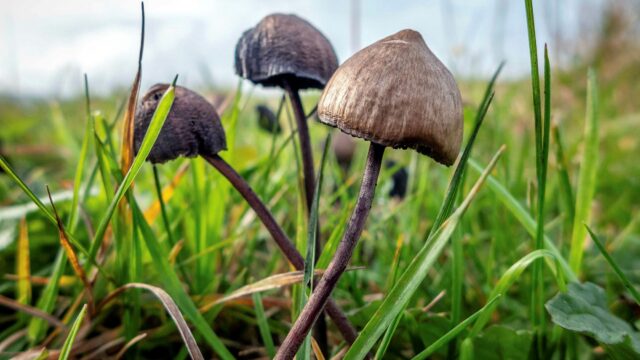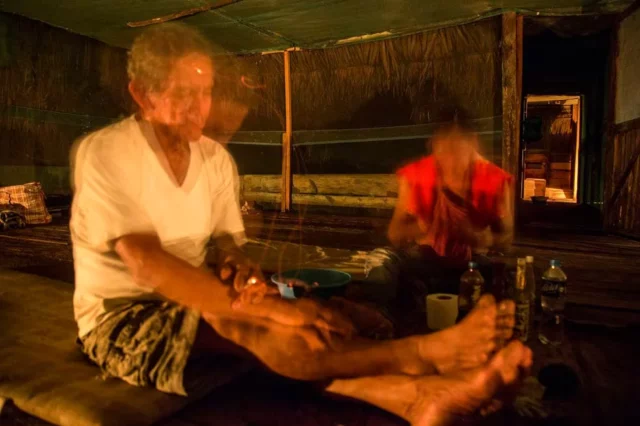Psychedelic drugs are gaining ground in medicine. After decades in silence, cornered by prohibition laws and the smear campaign of Richard Nixon’s government in the seventies, scientific research with MDMA, LSD, ketamine or psilocybin, present in hallucinogenic mushrooms, has emerged again to exploit its potential. therapeutic in mental health. There is already evidence on their side and the findings are now beginning to crystallize in clinical practice: esketamine, derived from ketamine, is already administered in a spray for people with resistant depression, and Australia has just become the first country in the world to allows the prescription of MDMA for post-traumatic stress and psilocybin against depression. The experts consulted admit that research with psychedelic drugs is “promising,” but the consistency of the benefits and knowledge about how these therapies should be implemented are still limited. And they ask for caution. They are not a panacea: they are not suitable for everything or for everyone.
They are ancient drugs. They have always been there. There are post-Paleolithic cave paintings in Cuenca that suggest the presence of fungi with neurotropic effects (Psilocybehispnica); Petroglyphs of mushrooms resembling the fly agaric have also been found on large rocks in Siberia; and the use of almost 20 species of Psilocybe is known for shamanic rites in Mexico. Whether in leisure contexts or in healing rituals, psychedelic substances have never gone away, but now they are gaining more and more prominence thanks to science, says Joana Bauzà, a psychiatrist at the Sant Pau Hospital in Barcelona trained in MDMA-assisted therapy: “The latest research and the change in public opinion has led to the so-called psychedelic renaissance, where scientists recover these substances to treat diseases,” he points out. So much so, that Science magazine recognized as one of the great findings of 2021 a work published in Nature Medicine that confirmed the effectiveness of MDMA in reducing the symptoms of post-traumatic stress: two months after the therapy, 67% of those who received the psychedelic drug no longer met the diagnostic criteria for this disorder, compared to 32% in the placebo group.
There is a list of candidates with therapeutic potential. Esketamine—a synthetic variant of ketamine, but without as many hallucinogenic and psychedelic effects—is already marketed for resistant depression. And the next ones that are nominated for approval from regulators are those approved in Australia: MDMA in post-traumatic stress and psilocybin for patients with depression refractory to conventional therapies. But there are also studies to extend psilocybin to eating disorders or people at the end of life, and research with ayahuasca and DMT (derived from this plant) to prevent prolonged grief or depression. 5-MeO-DMT, which is extracted from the bufo toad, is also to be tested for severe depression and the alkaloid ibogaine, found in the root of a Central African bush, to treat opioid addiction. All of them, to a greater or lesser extent, alter the state of consciousness and act on various areas of the brain. “They act differently from classic antidepressants and have more immediate effects,” summarizes Víctor Pérez, head of Psychiatry at the Hospital del Mar in Barcelona. His center recruited patients for an international study with psilocybin that was published in the prestigious New England Journal Medicine: a single dose managed to reduce the effects of resistant depression.
In practice, psychedelic therapy is a kind of journey. Patients live mystical experiences, there is an increase in the intensity of emotions, sensations of synesthesia, a dissolution of the ego, as if disconnection from the world, and they can revisit past experiences. “There is a higher capacity to connect ideas and memories,” adds Óscar Soto, a psychiatrist from Valld’Hebron and president of the Spanish Society of Psychedelic Medicine (Sempsi). With MDMA, for example, patients are able to revisit a traumatic situation without escaping from it.
They are not drugs with a high addictive potential, but Soto emphasizes that they have to be accompanied by psychotherapy and support from professionals during the psychedelic experience. Never alone. “We know that the environment where it is taken and the preparation are essential. Music, for example, is important because it conditions a series of effects and in a psychedelic state in which sensitivity to the environment is very high, it can be narrative, even cathartic,” he explains. A safe space must be prepared and strategies given to the patient to manage complex experiences on this psychological journey. The role of the therapist, who must have specific training to do all this, is to help navigate that experience: “The person is accompanied, so that they do not run away from what arises because it is very rich material to later use in psychotherapy.” , adds Soto.
What happens in the brain during these experiences is still being figured out. There are changes in brain neuroplasticity and also neurocognitive changes. The same patient can have completely different experiences with the same substance in two sessions. “Classic psychedelics, such as LSD, psilocybin or ayahuasca, act on the serotonin 5-HT2A receptor. It causes a generalized depolarization of pyramidal neurons and causes various areas of the brain to be better connected, favors a greater flow of information, causes synesthesia and mystical experiences may have to do with this dissolution of the neurons. On the other hand, dissociative anesthetics, such as ketamine and esketamine, act on the NMDA receptor and cause somewhat different effects,” argues Soto.
The investigation is still underway. Soto, for example, is recruiting patients for a study of ayahuasca assisted with psychotherapy for people with prolonged grief after a loss. Rosa Dueñas, psychiatrist and psychotherapist at the ParcSanitariSant Joan de Déu in Barcelona, for her part, will also start a phase II trial with 5-MeO-DMT for resistant depression in September: “This substance acts on serotonin reuptakers and, in Depending on the route of administration, they have a much faster effect: by inhalation, the effects appear in seconds and after 30 or 45 minutes, they are over. For it to be effective, it must be assisted by psychotherapy before and after [the psychedelic experience],” he explains. Preliminary trials with this substance, which originally comes from plants and a toad from the Sonoran Desert, are “promising”, up to 75% effective, says Dueñas, but the studies are small and further research is needed to confirm these success figures.
Controversial decision in Australia
The experts consulted agree that the evidence available on the potential of these substances is “promising”, but there is still some way to go. That is why Australia’s decision, which allows the prescription of MDMA and psilocybin from July 1, has been so controversial among the scientific community. In an open letter in the Australian & New Zealand Journal of Psychiatry, a group of researchers studying these substances rejected the decision. “Sufficient levels of evidence have not yet been generated to justify its large-scale implementation,” they argue. The scientists denounced that there are still questions to be resolved, such as what are the best models of psychotherapeutic care or how to differentiate the patients who would benefit the most: “Until these questions have been addressed in empirical research, the decision to increase public access outside of clinical trials is questionable, if not worrying,” they warned.
Bauzà, who is also a member of Sempsi, agrees that they should “have waited for more consistency and scientific evidence.” This therapy is not harmless: “One of the biggest risks is that the potential of psychedelics is overrated and that people read this and look outside to use it on their own and with untrained people. If taken in unsuitable environments and with unprepared people, the harmful effects can be very important,” he warns. For example, they are not recommended for people with previous episodes or a family history of psychosis. “Another risk is retraumatization if you experience experiences that you cannot manage. You can also remember things you didn’t remember and that can be traumatic and generate a new problem. And another risk is that of worsening the disease if adequate control is not carried out,” lists the psychiatrist from Sant Pau. Their center, which has an esketamine unit, will also participate in the 5-MeO-DMT study.

Not all substances are equally effective nor are they suitable for everyone. Nor is just anyone good enough to accompany you on the psychedelic journey. “What happened in Australia can end in a setback because if it is not implemented well, accompanied by good psychotherapy and infrastructure, it can lead to traumatic experiences,” Soto insists. Bauzà reinforces that message to the street: “It is not a panacea, it is a very important door that opens in psychiatry, but it must be explained that [psychedelic drugs] are not the salvation for all evils.”
The psychiatrist sees Australia’s decision as “hasty”: “When they were banned in 1971, it was for this reason: their use began to spread as a panacea and produced negative consequences and problems associated with consumption. And now we fear that the game will be repeated: we have been with a stigma and a huge lack of resources and now, by rushing, the same thing could happen again. The biggest challenge is not so much the effectiveness of the substance itself, but how you are going to use it as a treatment.”

Unknowns to be resolved
The research looks good, but many doubts remain to be resolved, agree the scientists consulted. To begin with, we must corroborate the evidence on the effectiveness of these substances in trials with more patients, clarify which profiles of patients will benefit the most and how the most beneficial psychotherapy should be. The appropriate therapeutic environment would also have to be enabled, Soto maintains, with adequate infrastructure and training for professionals. And it is necessary to reinforce ethical and deontological commitments to avoid abuse in sessions, the psychiatrist explains: “The framework that guarantees the patient’s safety must be very clear.” No violence, no sexual contact, and it is recommended that there are always two therapists, a man and a woman, and that the sessions be recorded. Risks must be minimized, Bauzà points out: “The code of conduct is super important, which differentiates the clinical part from the rituals. The patient has a portion of consciousness, but decision-making is altered and anything that happens there has to be controlled. The person is very vulnerable and we have to protect them because we can do a lot of good, but also a lot of harm.”
Pérez also considers that, although the severe symptoms of dissociative symptoms caused by psychedelics were temporary in the trials and the drugs seem safe, “a long-term therapeutic model is missing.” The psychiatrist knows that this substance will open a door to “sick people who had no possibilities,” but he asks for caution. He himself has a patient on the waiting list who participated in the trials and “immediately improved,” but relapsed again after a while. And he knows that these drugs can be an opportunity, but not before completing the research. “There is not enough evidence to put that on the market,” he says.
With the hope of effectiveness on one hand and deficiencies in implementation on the other, the most “sensible” thing, Bauzà agrees, is to wait: “We have a lot at stake. We have been waiting for 30 years. “It’s okay if we wait for something more.”

